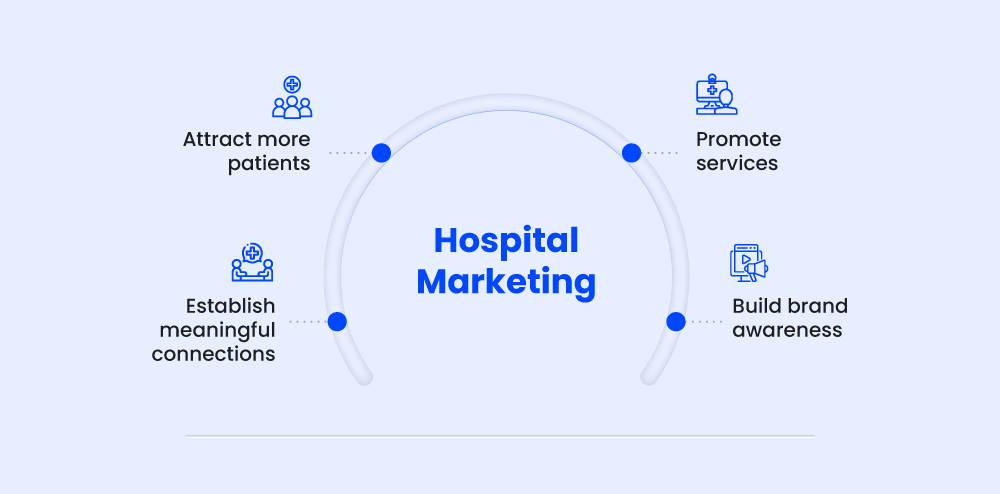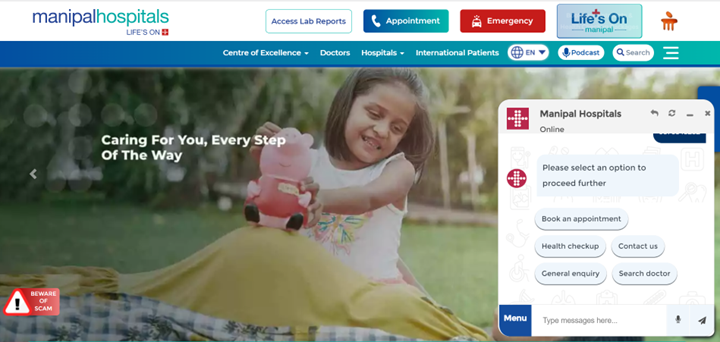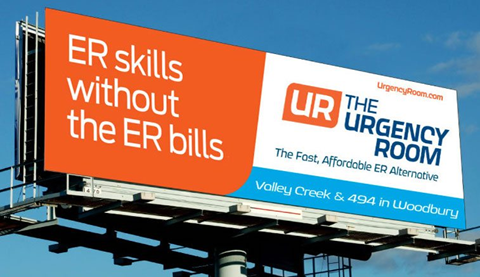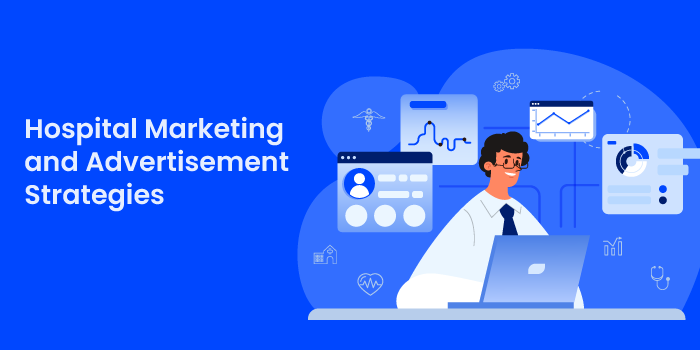Hospital marketing is nothing short of challenging, and there are two main reasons why:
First, no one wants to visit a hospital willingly. If patients are coming to you, it’s because they need immediate medical attention to get better.
And second, medical services are used by everyone. They’ve become something of a commodity, making it difficult for hospitals and other healthcare facilities to stand apart.
In either case, hospital marketing can help you acquire new patients, connect with them and ensure a healthy, profitable future.
Before we discuss the hospital marketing and hospital advertising strategies, let’s understand what marketing for a healthcare organization entails.
What is hospital marketing?

Hospital marketing is the strategic process of promoting and advertising the healthcare services and facilities offered by a hospital or healthcare institution. The aim of hospital marketing is to build brand awareness and reach and attract potential patients. It also helps in building positive relationships with existing patients and the community. There are various marketing strategies and channels, such as digital advertising, social media, content marketing, community outreach, and public relations. These channels help attract and engage patients, ultimately driving growth and success for the hospital.
Effective hospital advertising goes beyond simply promoting services; it aims to create a positive perception of the hospital brand and foster trust among potential patients. Targeted hospital advertising helps you to reach your desired audience and inspire them to choose you for their healthcare needs.
Top 12 hospital marketing and advertisement strategies
Don’t forget to analyze your competitors as well to find out what they are ranking for. Then devise an SEO plan and create content with the aim to rank on Google. This makes your hospital easy to find.
One more thing: don’t forget to do local SEO. This would simply mean ensuring that you register your hospital with GoogleMyBusiness. Then, you’d turn up on people’s searches when they use terms such as, ‘Hospitals near me’ or ‘Pediatricians near me’. Ensure you claim your address and use keywords that are relevant to your hospital/clinic.

1. Create a patient-centric website
Once you start with your hospital marketing activities, your website becomes the most essential asset. As for many patients, your website may be the first experience they have with your brand. Websites should be informative, but they also need to be helpful. Here are a few ways to improve your hospital’s website:
1. Optimize for mobile devices
To better cater to your patients, make sure your website is optimized for mobile devices.
Studies show that 55% of website traffic in general comes from mobile devices. Moreover, 92.3% of users access the internet using a mobile phone.
2. Create a user friendly interface
Ensure your design is clean, user-friendly, intuitive, and easy to navigate. Contact information should be prominently displayed, along with multiple options for patients to get in touch. In addition, you should include a patient FAQ that addresses the most common questions and enable self-service options, such as an appointment scheduler.
3. Integrate healthcare chatbots
Healthcare chatbots can solve basic inquiries instantly. Patients don’t have to wait for hours to connect with someone to help them with their questions, or book appointments. It also helps hospitals inform patients about the treatments and on-call doctors.

2. Ensure you rank on search engines
Make it easy for your patients to find you online. For your awesome hospital marketing activities to translate into business, people need to be able to find you first. Spend some time to understand what your patients are looking for in a healthcare provider. Then write blogs and share information around it. An easy keyword research can help you out!
You can use the following tools for keyword research and figure out what your target audience is searching for:
Don’t forget to analyze your competitors as well to find out what they are ranking for. Then devise an SEO plan and create content to rank on Google. This makes your hospital easy to find.
Another helpful tip: Invest in local SEO! 82.8% of people use search engines to find a healthcare provider. So, it is essential to ensure that you register your hospital with Google MyBusiness. Then, you’d turn up on people’s searches when they use terms such as, ‘Hospitals near me’ or ‘Pediatricians near me’. Ensure you claim your address and use keywords that are relevant to your hospital/clinic.
3. Exercise your brand on social media
Social media is an increasingly powerful tool in hospital marketing. Historically, hospitals have been slow to adopt social media as part of the mix, but it’s been shown to be a highly effective and free channel to build your brand. In October 2022, 4.74 billion people worldwide actively used at least one social media platform.
Interestingly, only about 13% of marketing budgets are allocated to social media marketing, even though 97% of marketers have adopted some form of social media presence. However, in 2022, social media accounted for approx. 33% of the average marketing spend.
Running paid advertisements for healthcare institutions can get a bit tricky since healthcare data is protected, and it limits targeting. But rather than promoting products and services, if you focus on building trust with your prospective patients, the results from marketing on social media can exceed your expectations.
Focus on delivering value with each post, such as helpful health-related content. If you can establish trust and authoritativeness in the healthcare sector, patient visits will become a natural by-product.
4. Run paid hospital advertising campaigns
Organic healthcare marketing is all well and good, but it comes with two major issues: it is slow and unpredictable. Cracking Google’s code is not so easy, as the algorithm keeps changing. Though the benefits are long-lasting if you want quicker results from your hospital advertising efforts, PPC campaigns may be the way to go.
Almost all social media platforms offer ad services, right from Facebook, Instagram, LinkedIn, Twitter, and even the new kid on the block: TikTok. You can run campaigns on these media and try to attract more patients to your website and improve visibility.
5. Add a human element to your brand
Most people associate hospitals with white, sterile environments, and brand images tend to follow this trend. However, you know you have much more to offer than a clean environment and top-notch care, so infuse the human side into your hospital marketing strategy.
A PwC study discovered that one in three consumers feel that trust is the most important element that influences their decision, even more so than price. Trust is imperative for a healthcare organization, after all your patients are entrusting their health and well-being to your facility, and you want them to feel confident about coming to you.
Focus on highlighting your providers, community partnerships, events, and other elements that will connect people to your brand. Social media can be a powerful outlet for humanizing your facility by letting patients see the doctors, nurses, and healthcare staff that make your hospital so special.
6. Engage in the community
Most local hospitals focus on serving niche or local communities, and the best way to reach them is simply by engaging with them.
A few ways that hospitals can stay active and contribute to the community are:
- Sponsor events
- Participate in or host health fairs
- Provide free wellness information
- Talk to local groups, and build your own community from within.
1. Organize healthcare webinars
Healthcare webinars are an effective way to advertise your facility and educate both existing and potential patients. But for that your webinar needs to be equal parts of interesting and informative.
Let’s look at a few steps that’ll help you organize an interactive healthcare webinar:
- Understand your audience and pick a relevant topic.
- Connect with experts, such as doctors, researchers, and healthcare counselors, and invite them as speakers
- Promote your webinar through various channels: Facebook, Instagram, YouTube, etc.
- Include polls during the session
- Allocate some time for a Q&A session at the end.
- Invite recurring patients and primary caregivers to attend support group sessions using email marketing.
7. Build long-term relationships for short-term care
While hospitals generally focuses on short-term treatments while advertising their services to patients, their efforts deliver long-term results. Because, the majority of patients you reach with your hospital advertising won’t need immediate medical attention, but they’ll be glad to know you’re on their side when they do need your expertise.
Focus on building long-term relationships with patients than focusing on immediate results. Building a positive brand image is a never-ending process, but with consistent effort over time, you’ll become a name that your patients can trust and rely on.
You can start with:
- Sending relevant information to patients about regular body check-ups or tips to improve their health.
- Update them about offers, such as membership plans or family plans, that can benefit them.
- Maintain transparency related to medical services and costs
- Ensure that all patient-related data is secure
8. Engage your patients with frequent email campaigns
Email campaigns are a powerful way to deliver targeted messages as a part of your hospital marketing initiatives. You can use email campaigns to:
- Share information about new services
- Send timely reminders for appointments or follow-ups
- Share healthcare or post-treatment care tips
To make the process efficient, you can use marketing automation software. It helps you automate email campaigns and generate reports to analyze their performance.
Tips to improve the open and conversion rates of your healthcare email campaigns:
- Curate a segmented list for your campaign to personalize the communication
- Ensure your healthcare email templates include an engaging email body, a good subject line, and a CTA at the end.
- Set up your email template on the platform to schedule the campaign and test which time works the best for your patients.
- Analyze open rate, CTR and conversions to improve future campaigns
9. Prioritize patient engagement in your hospital marketing plan
The aim of starting hospital marketing should not only be to attract patients but also to engage them. An efficient patient engagement plan will help you improve overall patient experience. Hospitals can focus on setting up automated yet personalized communications like sending appointment reminders, health tips, and birthday greetings. Collecting patient feedback through surveys or feedback forms helps identify areas for improvement. You can encourage patients to utilize patient portals for appointment scheduling and accessing medical records. The best channels for patient engagement are SMS, WhatsApp, and emails.
These ready-to-use SMS templates will get you started right away:
10. Patient reviews
According to a study by Neilsen, 92% of people trust recommendations from family and friends over any advertising. With this in mind, you should try to get your existing patients to share their experiences. Include a referral program in your hospital marketing strategy to incentivize your patients to recommend your hospital to their social circle. For example, you could offer a small discount on their next checkup or a voucher for an add-on service.
The next place where people look for validation is online reviews. Maintain a good online reputation by collecting feedback from patients after each consultation.
11. Leverage traditional media for healthcare advertising
Include traditional media in your hospital advertising plan. Though going digital is all well and good, the old school method still has some magic. Advertise your healthcare practice by running ads on newspapers, TV, billboards or even the radio. The downside of using traditional media is that it can get difficult to track where your revenue is coming from.

However, traditional media increases brand recall value. In times of emergency, you might very well be the first hospital that pops into the minds of your prospects.
12. Get referrals from doctors
A good hospital marketing plan should not only focus on patients but also on the other people involved in the journey of providing care, for example, doctors. Build a good relationship with the local doctor community. A lot of doctors own private clinics or work in smaller healthcare outlets. Informing them about your hospital’s amenities and the treatments that you provide will help them recommend you to their patients.
Now, you know the most effective healthcare marketing strategies. While each of these strategies requires significant time and constant improvement to succeed, they will eventually help your medical organization in a couple of ways.
Benefits of hospital marketing
Many of your hospital marketing initiatives will not deliver instant results. But if you continue with patience, you will start observing the following benefits:
1. Increased patient acquisition
Raising awareness about the hospital’s services, specialties, and expertise will eventually drive patient acquisition. It leads to hospital growth, higher appointments, and increases registrations.
2. Enhanced brand awareness and reputation
You can build and strengthen your healthcare practice’s brand identity. Consistent messaging and positive brand experiences contribute to building trust and establishing a reputable image within the community.
3. Improved patient engagement and loyalty
With hospital marketing you can deliver informative and valuable content, educate patients, and provide personalized experience. These efforts will cultivate loyalty and strengthen patient-provider relationships.
4. Targeted outreach and community engagement
Hospital advertising helps you target and reach specific demographics. By tailoring marketing campaigns to the needs and preferences of the target prospective patients, you can engage them more efficiently.
5. Strategic differentiation from competitors
One of the biggest benefits of hospital marketing is that you get an edge over your competitors. You can differentiate yourself by showcasing unique services, specialized expertise, cutting-edge technology, or exceptional patient experiences.
But, how would you know if our healthcare marketing efforts are hitting the mark? By tracking important metrics, you can understand the effectiveness of your campaigns and make data-driven decisions to drive even better results.
Let’s take a closer look at these KPIs.
Tips to ensure the success of your hospital marketing campaigns
1. Evaluating return on investment (ROI)
Your marketing campaigns are not delivering if they do not have positive ROI. To measure it, you need to track a few metrics and healthcare KPIs. A few important ones are:
- New patients acquired
- Conversion rates
- Engagement rate
- Revenue generated
Calculating the ROI will help you allocate resources wisely and double down on the most effective sources.
2.Identifying effective channels and tactics
Identify which marketing channels and practices drive the most engagement and generate the desired outcomes. To rank them by performance, track metrics like:
- Website traffic – The number of people visiting your website daily.
- Social media engagement – The number of likes, comments and shares on your post.
- Email open rates – The percentage of emails opened as compared to the total number of emails that have been delivered.
- Campaign performance – Calculate the reach, engagement and ROI of your other campaigns.
The most engaged sources and content help you understand what resonates best with your prospective patients.
3. Monitoring patient satisfaction and feedback
Go beyond quantitative metrics. You can also monitor patient satisfaction through surveys, reviews, and feedback mechanisms. This qualitative data offers invaluable insights into the patient experiences. It allows you to identify areas for improvement and address concerns promptly. Positive patient experiences drive loyalty, referrals, and ultimately contribute to the overall success of the hospital.
4. Continuous improvement and adaptation
Measuring and tracking activities provide hospitals with the opportunity to continuously learn, adapt, and improve their marketing strategies. You can do so, by analyzing data trends, identifying patterns, and conducting A/B testing. These experiments will refine your messaging and ensure you stay ahead of evolving patient expectations.
Conclusion
Hospital marketing drives growth, enhances patient engagement, and builds strong connections within the healthcare landscape. In this article we covered some best practices for hospital marketing and advertising. We also discussed how to measure the success of your campaigns and ensure continues growth.
If you are looking for a one-stop solution to plan and execute efficient marketing campaigns, check out Leadsquared.
FAQs
The 5 Ps of hospital marketing are Product (healthcare services), Price (cost of services), Place (hospital location), Promotion (marketing strategies), and People (target audience and staff).
The roles and responsibilities of hospital marketing include developing strategies to promote services, managing digital marketing, building relationships with healthcare providers, community outreach, public relations and monitoring campaign effectiveness.
The ethics of hospital marketing includes maintaining patient privacy and confidentiality. It also involves sharing accurate information and avoiding false or misleading advertising.









